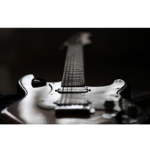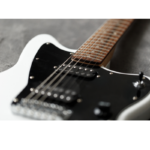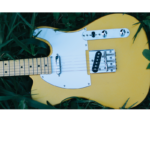Pentatonic guitar scales are reliable, easy to use and quick to apply to the fretboard. The scales can be applied to a simple chord progression rather quickly and they sound wonderful during improvisations. Play with a friend or a jam track on You Tube to help with timing. If you are just learning a minor pentatonic scale, take your time to fret each of the notes to ensure clarity on your instrument.
Connect Major & Minor Pentatonic Guitar Scales
One of the fastest ways to connect the notes on the fretboard is to learn both the major pentatonic scale and the minor pentatonic scale in the same key. These 2 scale patterns are right next to each other and provide an easy way to quickly play back and forth. If you were playing in the key of C, then your minor pentatonic would be on the 5th fret, top string. The major pentatonic scale would be on the 8th fret, top string. You can easily exchange notes in both of these scale. Alot of Blues guitar players will slide from major to minor in a blues improvisation.
A great song to listen to this technique is “Pride & Joy” by Stevie Ray Vaughan. During the intro Stevie slides up to the major pentatonic guitar scale and then slide back into an E minor pentatonic. Throughout the song he plays in between these 2 scale patterns.
Learn how to play each pattern in every key. You will start to visualize where all the major pentatonic and minor pentatonic guitar scales reside on the fretboard.
Play in each key
Use the circle of 5ths/4ths to play all the major pentatonics and minor pentatonics. Get to know your fretboard paired with keys. A simple practice session could look like this:
Key of C
- C Major Pentatonic, 8th fret
- A minor pentatonic, 5th fret
- Combine the scales
- Play with a jam track
Creating a habit for practice. Daily 20 min practice routines are a great start. Practice is progress, not perfection. Keep a practice journal to plan your sessions. This will help you stay on track. If you have big goals, write them down and progress towards them. The work is done in practice sessions.
“You can’t skip the practice and rely solely on talent. Practice is the bridge between your abilities and success”
Steve Nash
Learn triads within each pentatonic scale pattern
Another great way to understand pentatonic guitar scales is to find triads within the patterns. Triads are one of the most useful musical devices. They can be played as chords or as a melody in a solo. The sound of the triad is familiar to the ears. Even though, there are just 3 notes there is power in simplicity.
If we are playing a G minor pentatonic scale, we can play a G min triad with the 4th string, 3rd string and 2nd string. The notes of a G min triad are G, Bb, D. Find these notes all over the fretboard. You will be able to make great music with the simplicity of a triad. You can even write chord progressions with triads.
Practicing pentatonic guitar scales will open many creative outlets for you. Don’t be afraid to make mistakes. Progress comes from hitting the wrong note and training your fingers to hit the right notes.

Justin Comstock
Host of the Guitar Freaks Podcast
Justin is a Blues guitarist from Utah. He created a guitar learning tool called the FretDeck on Kickstarter that has helped many guitar players master the fretboard. He is also the host of the Guitar Freaks Podcast.
Download his free tools for learning guitar.










